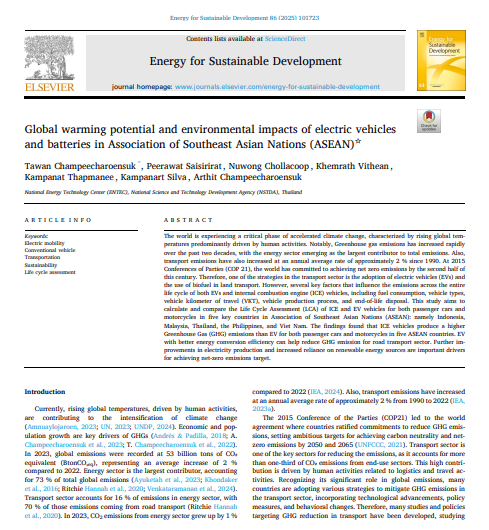
Keyword(s)
Author(s)
Tawan Champeecharoensuk, Peerawat Saisirirat, Nuwong Chollacoop, Khemrath Vithean, Kampanat Thapmanee, Kampanart Silva, Arthit Champeecharoensuk
Country(ies)
Publisher
Published Date
Access
DOI
National Energy Technology Center (ENTEC), National Science and Technology Development Agency (NSTDA), Thailand
The world is experiencing a critical phase of accelerated climate change, characterized by rising global temperatures predominantly driven by human activities. Notably, Greenhouse gas emissions has increased rapidly over the past two decades, with the energy sector emerging as the largest contributor to total emissions. Also, transport emissions have also increased at an annual average rate of approximately 2 % since 1990. At 2015 Conferences of Parties (COP 21), the world has committed to achieving net zero emissions by the second half of this century. Therefore, one of the strategies in the transport sector is the adoption of electric vehicles (EVs) and the use of biofuel in land transport. However, several key factors that influence the emissions across the entire life cycle of both EVs and internal combustion engine (ICE) vehicles, including fuel consumption, vehicle types, vehicle kilometer of travel (VKT), vehicle production process, and end-of-life disposal. This study aims to calculate and compare the Life Cycle Assessment (LCA) of ICE and EV vehicles for both passenger cars and motorcycles in five key countries in Association of Southeast Asian Nations (ASEAN): namely Indonesia, Malaysia, Thailand, the Philippines, and Viet Nam. The findings found that ICE vehicles produce a higher Greenhouse Gas (GHG) emissions than EV for both passenger cars and motorcycles in five ASEAN countries. EV with better energy conversion efficiency can help reduce GHG emission for road transport sector. Further improvements in electricity production and increased reliance on renewable energy sources are important drivers for achieving net-zero emissions target.